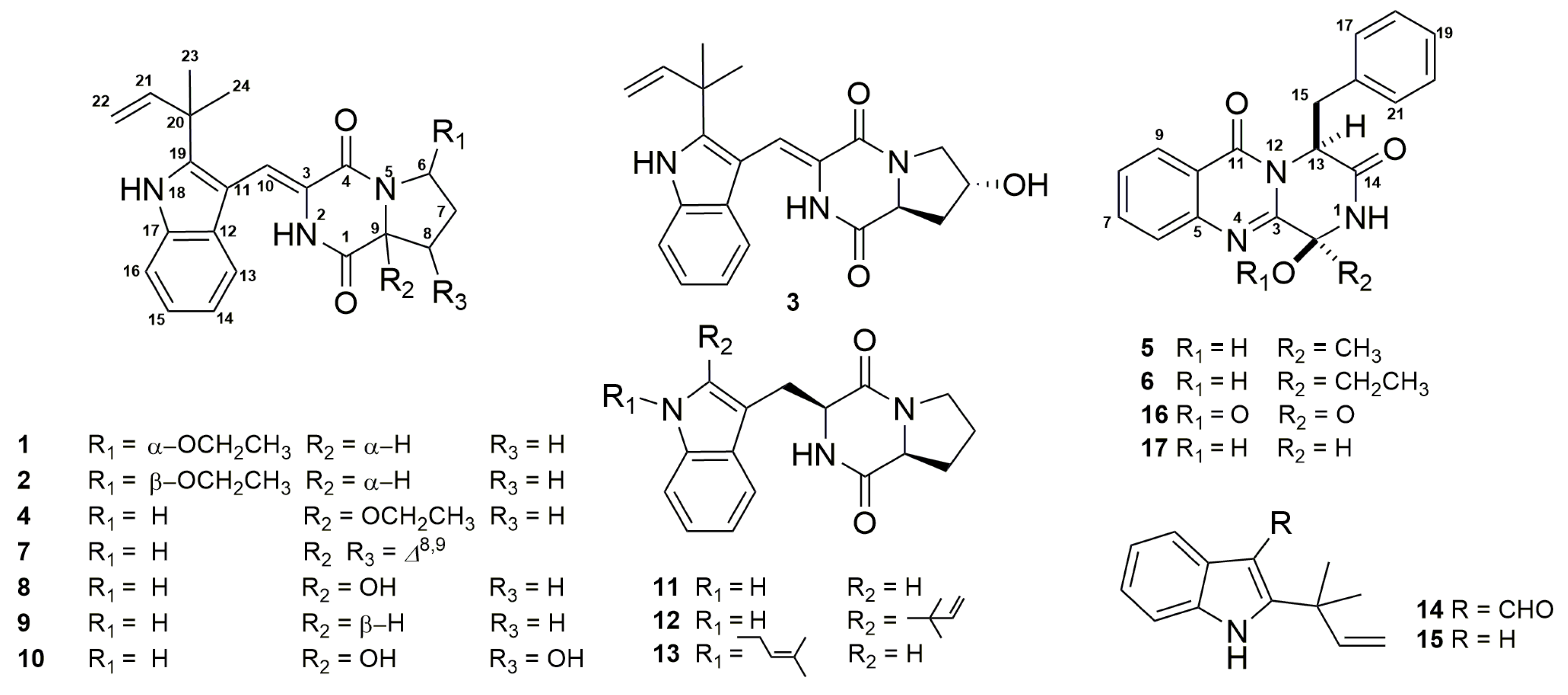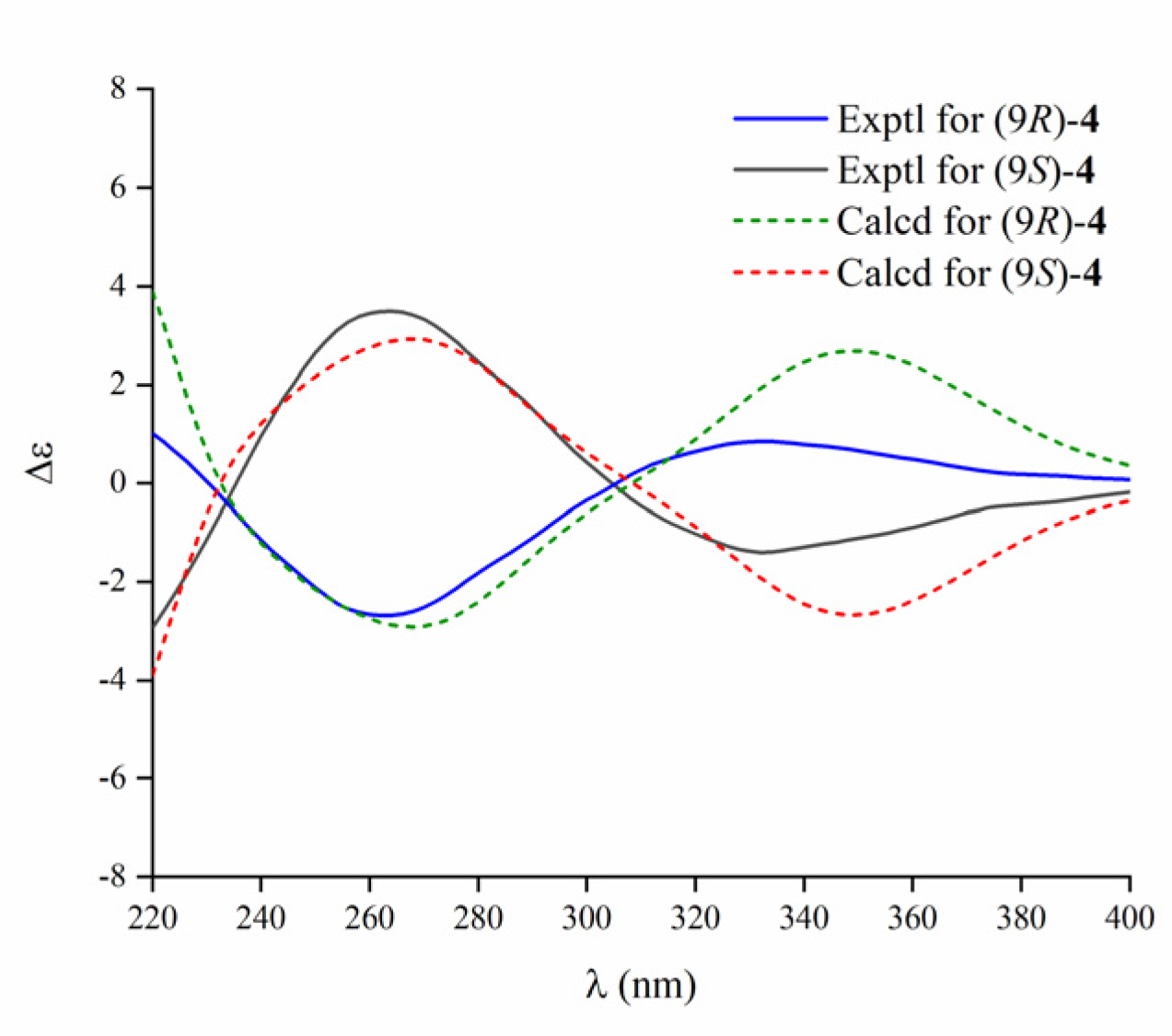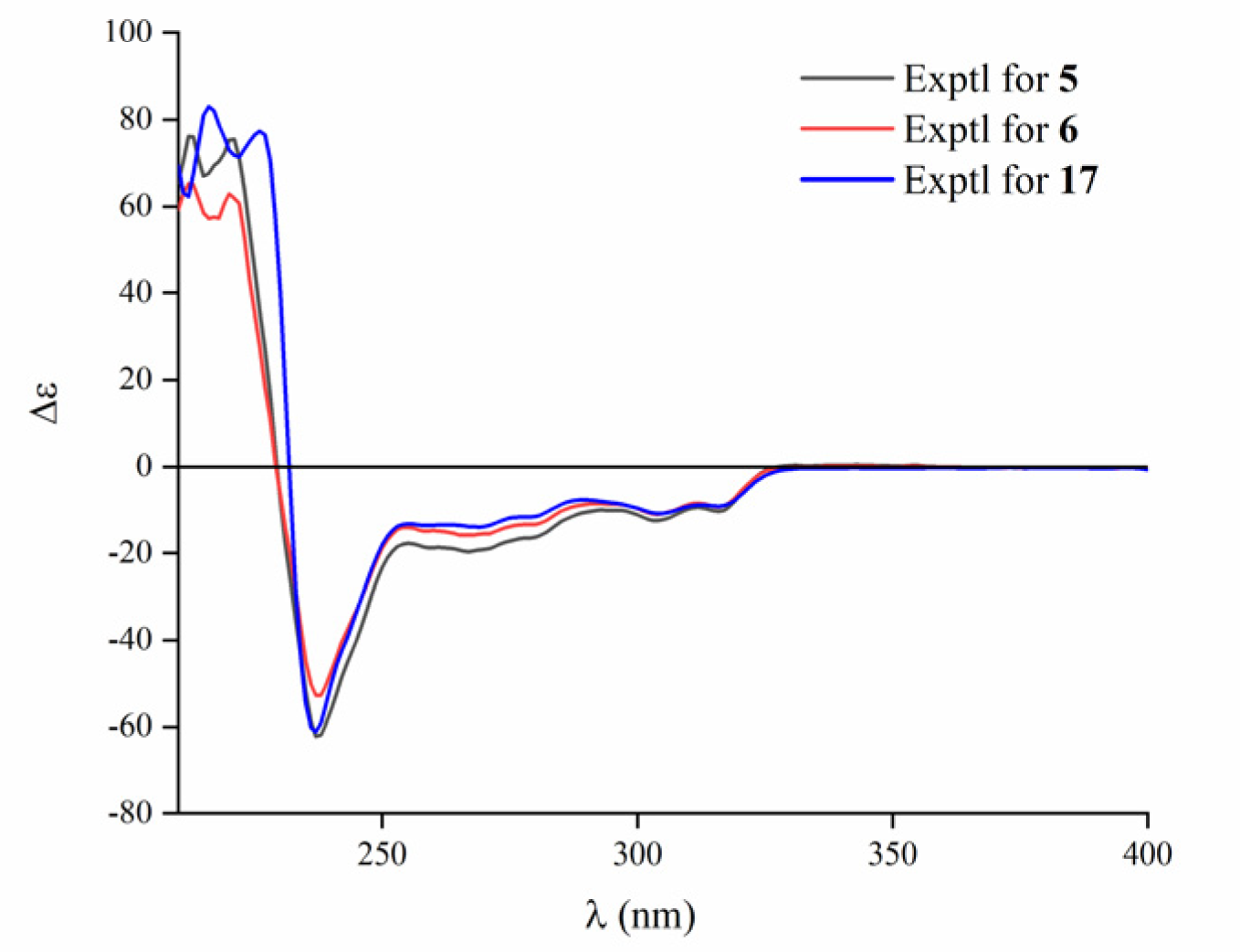Bioactive Indolyl Diketopiperazines from the Marine Derived Endophytic Aspergillus versicolor DY180635
Abstract
:1. Introduction
2. Results and Discussion
3. Materials and Methods
3.1. General Experimental Procedures
3.2. Fungal Material
3.3. Fermentation, Extraction, and Isolation
3.4. ECD Calculation
3.5. Virtual Screening Against COVID-19 Main Protease
3.5.1. Protein and Ligand Preparation
3.5.2. Virtual Screening
3.6. Cell Culture and Cell Viability Assay
4. Conclusions
Supplementary Materials
Author Contributions
Funding
Conflicts of Interest
References
- Strobel, G.; Daisy, B.; Castillo, U.; Harper, J. Natural products from endophytic microorganisms. J. Nat. Prod. 2004, 67, 257–268. [Google Scholar] [CrossRef]
- Blunt, J.W.; Copp, B.R.; Keyzers, R.A.; Munro, M.H.G.; Prinsep, M.R. Marine natural products. Nat. Prod. Rep. 2017, 34, 235–294. [Google Scholar] [CrossRef] [PubMed] [Green Version]
- Bugni, T.S.; Ireland, C.M. Marine-derived fungi: A chemically and biologically diverse group of microorganisms. Nat. Prod. Rep. 2004, 21, 143–163. [Google Scholar] [CrossRef]
- Ma, Y.M.; Liang, X.A.; Kong, Y.; Jia, B. Structural diversity and biological activities of indole diketopiperazine alkaloids from fungi. J. Agric. Food Chem. 2016, 64, 6659–6671. [Google Scholar] [CrossRef] [PubMed]
- Borthwick, A.D. 2,5-Diketopiperazines: Synthesis, reactions, medicinal chemistry, and bioactive natural products. Chem. Rev. 2012, 112, 3641–3716. [Google Scholar] [CrossRef] [PubMed]
- Wang, W.L.; Lu, Z.Y.; Tao, H.W.; Zhu, T.J.; Fang, Y.C.; Gu, Q.Q.; Zhu, W.M. Isoechinulin-type alkaloids, variecolorins A-L, from halotolerant Aspergillus variecolor. J. Nat. Prod. 2007, 70, 1558–1564. [Google Scholar] [CrossRef]
- Cai, S.X.; Sun, S.W.; Peng, J.X.; Kong, X.L.; Zhou, H.N.; Zhu, T.J.; Gu, Q.Q.; Li, D.H. Okaramines S-U, three new indole diketopiperazine alkaloids from Aspergillus taichungensis ZHN-7-07. Tetrahedron 2015, 71, 3715–3719. [Google Scholar] [CrossRef]
- Wang, F.Z.; Fang, Y.C.; Zhu, T.J.; Zhang, M.; Lin, A.Q.; Gu, Q.Q.; Zhu, W.M. Seven new prenylated indole diketopiperazine alkaloids from holothurian-derived fungus Aspergillus fumigatus. Tetrahedron 2008, 64, 7986–7991. [Google Scholar] [CrossRef]
- Tsukamoto, S.; Kato, H.; Samizo, M.; Nojiri, Y.; Onuki, H.; Hirota, H.; Ohta, T. Notoamides F−K, prenylated indole alkaloids isolated from a marine-derived Aspergillus sp. J. Nat. Prod. 2008, 71, 2064–2067. [Google Scholar] [CrossRef]
- Kozlovsky, A.G.; Vinokurova, N.G.; Adanin, V.M. Diketopiperazine alkaloids from the fungus Penicillium piscarium westling. Appl. Biochem. Microbiol. 2000, 36, 271–275. [Google Scholar] [CrossRef]
- Ravikanth, V.; Niranjan Reddy, V.L.; Ramesh, P.; Prabhakar Rao, T.; Diwan, P.V.; Khar, A.; Venkateswarlu, Y. An immunosuppressive tryptophan-derived alkaloid from Lepidagathis cristata. Phytochemistry 2001, 58, 1263–1266. [Google Scholar] [CrossRef]
- Fujimoto, H.; Sumino, M.; Okuyama, E.; Ishibashi, M. Immunomodulatory constituents from an Ascomycete. J. Nat. Prod. 2004, 67, 98–102. [Google Scholar] [CrossRef]
- Kuramochi, K.; Ohnishi, K.; Fujieda, S.; Nakajima, M.; Saitoh, Y.; Watanabe, N.; Takeuchi, T.; Nakazaki, A.; Sugawara, F.; Arai, T.; et al. Synthesis and biological activities of neoechinulin A derivatives: New aspects of structure-activity relationships for neoechinulin A. Chem. Pharm. Bull. 2008, 56, 1738–1743. [Google Scholar] [CrossRef] [PubMed] [Green Version]
- Fan, Z.; Sun, Z.H.; Liu, Z.; Chen, Y.C.; Liu, H.X.; Li, H.H.; Zhang, W.M. Dichotocejpins A-C: New diketopiperazines from a deep-sea-derived fungus Dichotomomyces cejpii FS110. Mar. Drugs 2016, 14, 1–9. [Google Scholar] [CrossRef] [PubMed] [Green Version]
- Mohanlal, R.W.; Lloyd, K.; Huang, L. Plinabulin, a novel small molecule clinical stage IO agent with anti-cancer activity, to prevent chemo-induced neutropenia and immune related AEs. J. Clin. Oncol. 2018, 36, 126. [Google Scholar] [CrossRef]
- Gomes, N.G.M.; Lefranc, F.; Kijjoa, A.; Kiss, R. Can some marine-ferived fungal metabolites become actual anticancer agents? Mar. Drugs 2015, 13, 3950–3991. [Google Scholar] [CrossRef]
- Geiger, W.B.; Conn, J.E.; Waksman, S.A. Chaetomin, a new antibiotic substance produced by Chaetomium cochliodes: II. Isolation and Concentration. J. Bacteriol. 1944, 48, 531–536. [Google Scholar] [CrossRef] [Green Version]
- Tian, W.; Sun, C.; Zheng, M.; Harmer, J.R.; Yu, M.; Zhang, Y.; Peng, H.; Zhu, D.; Deng, Z.; Chen, S.L.; et al. Efficient biosynthesis of heterodimeric C3-aryl pyrroloindoline alkaloids. Nat. Commun. 2018, 9, 4428. [Google Scholar] [CrossRef]
- Ye, Y.; Du, L.; Zhang, X.W.; Newmister, S.A.; McCauley, M.; Alegre-Requena, J.V.; Zhang, W.; Mu, S.; Minami, A.; Fraley, A.E.; et al. Fungal-derived brevianamide assembly by a stereoselective semipinacolase. Nat. Catal. 2020. [Google Scholar] [CrossRef]
- Song, F.; Liu, X.; Guo, H.; Ren, B.; Chen, C.; Piggott, A.M.; Yu, K.; Gao, H.; Wang, Q.; Liu, M.; et al. Brevianamides with antitubercular potential from a marine-derived isolate of Aspergillus versicolor. Org. Lett. 2012, 14, 4770–4773. [Google Scholar] [CrossRef]
- James, E.D.; Knuckley, B.; Alqahtani, N.; Porwal, S.; Ban, J.; Karty, J.A.; Viswanathan, R.; Lane, A.L. Two distinct cyclodipeptide synthases from a marine Actinomycete catalyze biosynthesis of the same diketopiperazine natural product. ACS Synth. Biol. 2016, 5, 547–553. [Google Scholar] [CrossRef] [PubMed]
- Haines, B.E.; Nelson, B.M.; Grandner, J.M.; Kim, J.; Houk, K.N.; Movassaghi, M.; Musaev, D.G. Mechanism of permanganate-promoted dihydroxylation of complex diketopiperazines: Critical roles of counter-cation and ion-pairing. J. Am. Chem. Soc. 2018, 140, 13375–13386. [Google Scholar] [CrossRef] [Green Version]
- Ding, Y.; An, F.L.; Zhu, X.J.; Yu, H.Y.; Hao, L.L.; Lu, Y.H. Curdepsidones B-G, six depsidones with anti-inflammatory activities from the marine-derived fungus Curvularia sp. IFB-Z10. Mar. Drugs 2019, 17, 266. [Google Scholar] [CrossRef] [Green Version]
- Liu, W.H.; Ding, Y.; Ji, X.; An, F.L.; Lu, Y.H. Curvulaide A, a bicyclic polyketide with anti-anaerobic bacteria activity from marine-derived Curvularia sp. J. Antibiot. 2019, 72, 111–113. [Google Scholar] [CrossRef]
- Guo, M.M.; Lu, Y.; Yang, J.P.; Zhao, X.; Lu, Y.H. Inhibitory effects of Schisandra chinensis extract on acne-related inflammation and UVB-induced photoageing. Pharm. Biol. 2016, 54, 2987–2994. [Google Scholar] [CrossRef] [PubMed] [Green Version]
- Dillman, R.L.; Cardellina, J.H. Aromatic secondary metabolites from the sponge Tedania ignis. J. Nat. Prod. 1991, 54, 1056–1061. [Google Scholar] [CrossRef]
- Jin, Z.M.; Du, X.Y.; Xu, Y.C.; Deng, Y.Q.; Liu, M.Q.; Zhao, Y.; Zhang, B.; Li, X.F.; Zhang, L.K.; Peng, C.F.; et al. Structure of Mpro from COVID-19 virus and discovery of its inhibitors. Nature 2020, 582, 289–293. [Google Scholar] [CrossRef] [PubMed] [Green Version]
- Li, G.Y.; Yang, T.; Luo, Y.G.; Chen, X.Z.; Fang, D.M.; Zhang, G.L. Brevianamide J, a new indole alkaloid dimer from fungus Aspergillus versicolor. Org. Lett. 2009, 11, 3714–3717. [Google Scholar] [CrossRef]
- Li, G.Y.; Li, L.M.; Yang, T.; Chen, X.Z.; Fang, D.M.; Zhang, G.L. Four new alkaloids, brevianamides O-R, from the fungus Aspergillus versicolor. Helv. Chim. Acta 2010, 93, 2075–2080. [Google Scholar] [CrossRef]
- Liu, Y.X.; Ma, S.G.; Wang, X.J.; Zhao, N.; Qu, J.; Yu, S.S.; Dai, J.G.; Wang, Y.H.; Si, Y.K. Diketopiperazine alkaloids produced by the endophytic fungus Aspergillus fumigatus from the Stem of Erythrophloeum fordii Oliv. Helv. Chim. Acta 2012, 95, 1401–1408. [Google Scholar] [CrossRef]
- Schkeryantz, J.M.; Woo, J.C.G.; Siliphaivanh, P.; Depew, K.M.; Danishefsky, S.J. Total synthesis of gypsetin, deoxybrevianamide E, brevianamide E, and tryprostatin B: Novel constructions of 2,3-disubstituted indoles. J. Am. Chem. Soc. 1999, 121, 11964–11975. [Google Scholar] [CrossRef]
- Sanz-Cervera, J.F.; Stocking, E.M.; Usui, T.; Osada, H.; Williams, R.M. Synthesis and evaluation of microtubule assembly inhibition and cytotoxicity of prenylated derivatives of cyclo-l-Trp-l-Pro. Bioorg. Med. Chem. 2000, 8, 2407–2415. [Google Scholar] [CrossRef]
- May Zin, W.W.; Buttachon, S.; Dethoup, T.; Pereira, J.A.; Gales, L.; Inácio, Â.; Costa, P.M.; Lee, M.; Sekeroglu, N.; Silva, A.M.S.; et al. Antibacterial and antibiofilm activities of the metabolites isolated from the culture of the mangrove-derived endophytic fungus Eurotium chevalieri KUFA 0006. Phytochemistry 2017, 141, 86–97. [Google Scholar] [CrossRef] [PubMed]
- Pirrung, M.C.; Fujita, K.; Park, K. Organometallic routes to 2,5-dihydroxy-3-(indol-3-yl)-benzoquinones. Synthesis of demethylasterriquinone B4. J. Org. Chem. 2005, 70, 2537–2542. [Google Scholar] [CrossRef]
- Liu, W.; Wang, L.P.; Wang, B.; Xu, Y.C.; Zhu, G.L.; Lan, M.M.; Zhu, W.M.; Sun, K.L. Diketopiperazine and diphenylether derivatives from marine algae-derived Aspergillus versicolor OUCMDZ-2738 by epigenetic activation. Mar. Drugs 2019, 17, 6. [Google Scholar] [CrossRef] [Green Version]
- Markowitz, M.; Saag, M.; Powderly, W.G.; Hurley, A.M.; Hsu, A.; Valdes, J.M.; Henry, D.; Sattler, F.; La Marca, A.; Leonard, J.M.; et al. A preliminary study of ritonavir, an inhibitor of HIV-1 protease, to treat HIV-1 infection. N. Engl. J. Med. 1995, 333, 1534–1539. [Google Scholar] [CrossRef]
- Halgren, T.A.; Murphy, R.B.; Friesner, R.A.; Beard, H.S.; Frye, L.L.; Pollard, W.T.; Banks, J.L. Glide: A new approach for rapid, accurate docking and scoring. 2. Enrichment factors in database screening. J. Med. Chem 2004, 47, 1750–1759. [Google Scholar] [CrossRef]






| No. | 1 | 2 | 3 | |||
|---|---|---|---|---|---|---|
| δC | δH, Mult. (J in Hz) | δC | δH, Mult. (J in Hz) | δC | δH, Mult. (J in Hz) | |
| 1 | 165.9 | - | 166.8 | - | 166.2 | - |
| 2 | - | 9.01, s | - | 9.43, s | - | 8.93, s |
| 3 | 125.3 | - | 125.9 | - | 126.2 | - |
| 4 | 158.9 | - | 161.1 | - | 158.4 | - |
| 6a | 86.7 | 5.59, dd (5.7, 1.7) | 85.4 | 5.35, dd (2.8, 1.7) | 54.4 | 3.32, m |
| 6b | - | - | - | - | - | 3.75, dd (12.7, 4.5) |
| 7a | 29.6 | 1.75, dddd (13.4, 8.4, 5.0, 1.7) | 30.7 | 1.92, m | 66.6 | 4.35, t (4.5) |
| 7b | 1.97, m | - | ||||
| 8a | 25.9 | 2.13, dddd (12.2, 9.7, 6.7, 5.0) | 24.5 | 1.92, m | 37.6 | 1.98, ddd (12.7, 11.5, 4.5) |
| 8b | 2.27, m | 2.10, m | 2.12, dd (12.7, 6.0) | |||
| 9 | 56.5 | 4.57, dd (8.9, 6.7) | 58.7 | 4.44, m | 57.0 | 4.65, dd (11.5, 6.0) |
| 10 | 111.9 | 6.98, s | 113.2 | 7.05, s | 110.7 | 6.92, s |
| 11 | 103.9 | - | 104.3 | - | 103.8 | - |
| 12 | 125.9 | - | 125.8 | - | 126.0 | - |
| 13 | 119.6 | 7.29, d (8.0) | 119.7 | 7.23, d (8.0) | 119.4 | 7.29, d (8.0) |
| 14 | 119.4 | 6.99, m | 119.3 | 6.99, ddd (8.0, 7.0, 1.2) | 119.3 | 7.00, m |
| 15 | 120.7 | 7.08, ddd (8.0, 7.0, 1.2) | 120.7 | 7.07, ddd (8.0, 7.0, 1.2) | 120.7 | 7.08, ddd (8.0, 7.0, 1.2) |
| 16 | 111.5 | 7.41, d (8.0) | 111.6 | 7.41, m | 111.4 | 7.41, d (8.0) |
| 17 | 135.1 | - | 135.1 | - | 135.1 | - |
| 18 | 11.06, s | - | 11.06, s | - | 11.03, s | |
| 19 | 144.3 | - | 144.7 | - | 144.0 | - |
| 20 | 39.0 | - | 39.1 | - | 39.0 | - |
| 21 | 145.1 | 6.07, dd (17.4, 10.5) | 145.1 | 6.09, dd (17.1, 10.8) | 145.2 | 6.08, dd (17.3, 10.5) |
| 22 | 111.7 | 5.05, m | 111.7 | 5.06, m | 111.6 | 5.04, m |
| 23 | 27.4 | 1.45, s | 27.5 | 1.47, s | 27.4 | 1.46, s |
| 24 | 27.8 | 1.49, s | 27.9 | 1.51, s | 27.7 | 1.50, s |
| 6-OEt | 63.6 | 3.65, m | 64.3 | 3.60, m | - | - |
| 15.2 | 1.13, t (7.1) | 15.4 | 1.09, t (7.1) | - | - |
| No. | 4 | 5 | 6 | |||
|---|---|---|---|---|---|---|
| δ | δH, Mult. (J in Hz) | δC | δH, Mult. (J in Hz) | δC | δH, Mult. (J in Hz) | |
| 1 | 163.1 | - | - | - | - | - |
| 2 | - | 9.43, s | 83.9 | 5.27, d (4.7) | 78.3 | 6.40, d (4.3) |
| 3 | 125.5 | - | 146.9 | - | 151.1 | - |
| 4 | 159.4 | - | - | - | - | |
| 5 | - | - | 146.7 | - | 139.0 | - |
| 6 | 45.1 | 3.62, dd (8.6, 5.8) | 127.8 | 7.74, d (8.0) | 122.9 | 8.23, d, (8.0) |
| 7a | 19.5 | 1.92, m | 134.9 | 7.79, t (8.0) | 136.7 | 7.91, t (8.0) |
| 7b | 1.96, m | |||||
| 8a | 32.4 | 2.02, m | 128.0 | 7.53, t (8.0) | 129.7 | 7.66, t (8.0) |
| 8b | 2.33, m | |||||
| 9 | 91.0 | - | 127.0 | 8.24, d (8.0) | 127.9 | 8.23, d, (8.0) |
| 10 | 112.7 | 7.02, s | 120.8 | - | 119.1 | - |
| 11 | 103.9 | - | 160.3 | - | 157.4 | - |
| 12 | 126.3 | - | - | - | - | - |
| 13 | 119.1 | 7.21, d (8.0) | 57.4 | 5.53, dd (8.8, 6.5) | 58.1 | 5.54, t (7.8) |
| 14 | 119.0 | 7.00, m | 170.0 | - | 167.6 | - |
| 15 | 120.7 | 7.09, m | 40.0 | 3.43, m | 39.9 | 3.48, m |
| 16 | 111.6 | 7.43, d (8.0) | 135.9 | - | 134.9 | - |
| 17 | 135.1 | - | 129.8 | 7.29, m | 129.7 | 7.24, m |
| 18 | 11.10, s | 128.6 | 7.28, m | 128.8 | 7.24, m | |
| 19 | 144.4 | - | 127.0 | 7.24, m | 127.7 | 7.20, m |
| 20 | 39.0 | - | 128.6 | 7.28, m | 128.8 | 7.24, m |
| 21 | 145.2 | 6.09, ddd (17.1, 10.8, 1.6) | 129.8 | 7.29, m | 129.7 | 7.24, m |
| 22 | 111.7 | 5.06, m | - | - | - | - |
| 23 | 27.4 | 1.47, s | - | - | - | - |
| 24 | 27.8 | 1.50, s | - | - | - | - |
| 9-OEt | 59.2 | 3.53, qd (7.0, 3.9) | - | - | - | - |
| - | 15.2 | 1.22, td (7.0, 1.5) | - | - | - | - |
| 2-OMe/ 2-OEt | - | - | 56.0 | 3.53, s | 66.2 | 4.04, dt (9.0, 7.0) |
| 4.11, dt (9.0, 7.0) | ||||||
| - | - | - | - | 15.4 | 1.35, t (7.0) |
© 2020 by the authors. Licensee MDPI, Basel, Switzerland. This article is an open access article distributed under the terms and conditions of the Creative Commons Attribution (CC BY) license (http://creativecommons.org/licenses/by/4.0/).
Share and Cite
Ding, Y.; Zhu, X.; Hao, L.; Zhao, M.; Hua, Q.; An, F. Bioactive Indolyl Diketopiperazines from the Marine Derived Endophytic Aspergillus versicolor DY180635. Mar. Drugs 2020, 18, 338. https://doi.org/10.3390/md18070338
Ding Y, Zhu X, Hao L, Zhao M, Hua Q, An F. Bioactive Indolyl Diketopiperazines from the Marine Derived Endophytic Aspergillus versicolor DY180635. Marine Drugs. 2020; 18(7):338. https://doi.org/10.3390/md18070338
Chicago/Turabian StyleDing, Yi, Xiaojing Zhu, Liling Hao, Mengyao Zhao, Qiang Hua, and Faliang An. 2020. "Bioactive Indolyl Diketopiperazines from the Marine Derived Endophytic Aspergillus versicolor DY180635" Marine Drugs 18, no. 7: 338. https://doi.org/10.3390/md18070338





